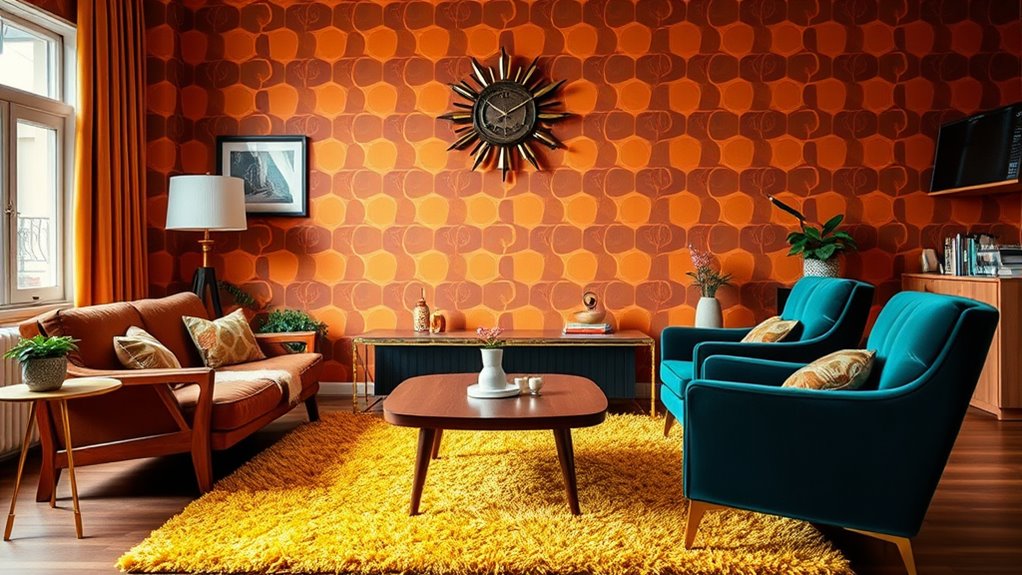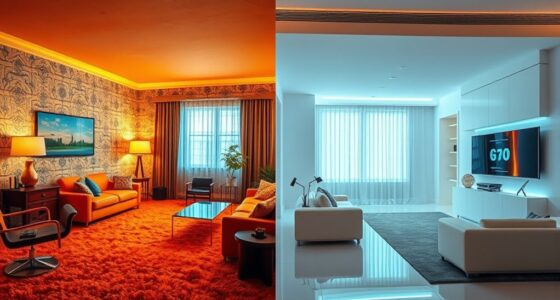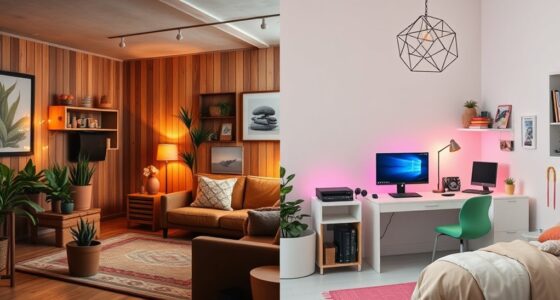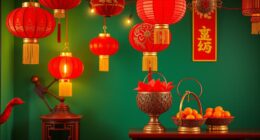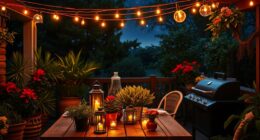You might notice 1970s décor making a comeback because its bold colors, unique patterns, and nostalgic vibe still attract many. This style taps into your desire for warmth, familiarity, and artistic expression, creating lively, inviting spaces. Media, pop culture, and trends cycle back, reintroducing vintage elements with a fresh twist. Understanding how nostalgia and the trend cycle influence design can help you see why this retro style remains timeless—if you keep exploring, you’ll uncover even more.
Key Takeaways
- Nostalgia for the 1970s evokes emotional comfort, prompting a revival of its vibrant and eclectic design elements.
- Media reboots and pop culture influence rekindle interest in vintage styles, fueling the trend cycle.
- The cyclical nature of fashion and interior design causes styles like 1970s décor to periodically re-emerge.
- Modern adaptations blend retro aesthetics with contemporary trends, keeping the style fresh and relevant.
- Cultural shifts and a desire for authenticity drive a renewed appreciation for the bold patterns and textures of the era.
The Defining Features of 1970s Interior Design
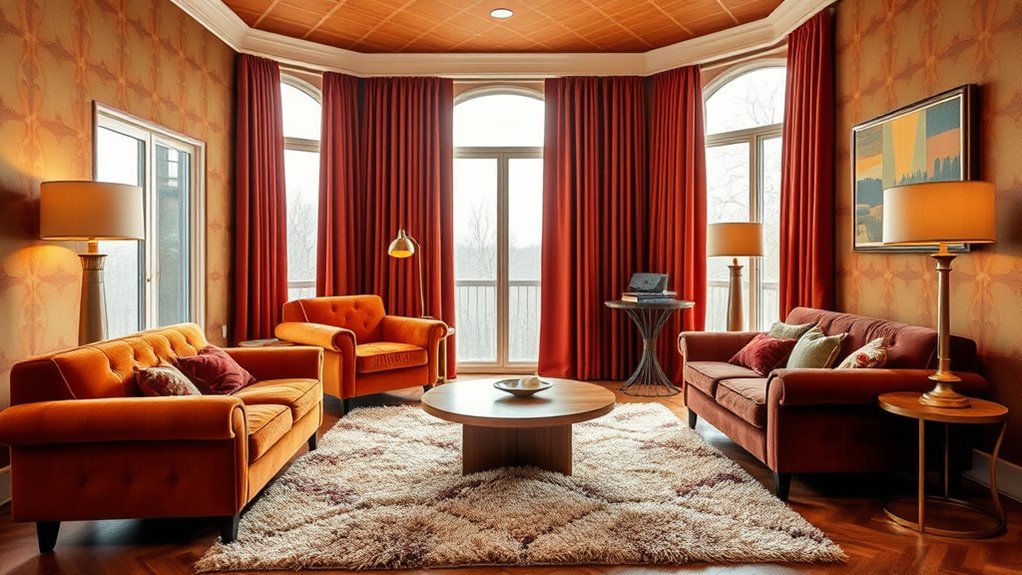
The defining features of 1970s interior design are bold, eclectic, and unapologetically vibrant. You’ll notice the striking color palettes, often mixing earthy tones with bright oranges, yellows, and teals that create energetic spaces. These hues reflect the decade’s adventurous spirit. Furniture shapes are just as distinctive—think low-slung sofas, rounded edges, and geometric forms that emphasize comfort and modernity. The emphasis on playful, unconventional designs makes the interiors feel lively and inviting. You’re encouraged to experiment with patterns, textures, and asymmetry, giving each room a dynamic personality. Overall, 1970s design invites you to embrace individuality through expressive colors and innovative furniture shapes that break away from traditional styles.
The Psychological Appeal of Vintage Styles

Vintage styles evoke nostalgia and comfort, making your space feel familiar and inviting. They also showcase unique artistic expression, reflecting your personality and taste. Ultimately, connecting to the past through retro décor can provide a sense of stability and emotional grounding. Additionally, incorporating elements like safety standards ensures your vintage-inspired space remains safe and compliant with current regulations.
Nostalgia and Comfort
As you walk into a room decorated with 1970s-inspired elements, you may notice an immediate sense of warmth and familiarity that instantly comforts you. This nostalgia taps into your desire for safety and stability, reminding you of simpler times. Vintage styles like mid-century modern and bohemian aesthetic evoke positive memories and create a cozy atmosphere. They connect you to a past where life felt more relaxed and authentic. The familiar textures, patterns, and colors soothe your mind and reduce stress, making your space feel like a retreat. Additionally, incorporating paint sprayer techniques can help you achieve a smooth, professional finish that enhances the vintage look and makes your decor stand out.
Unique Artistic Expression
When you incorporate 1970s-inspired decor into your space, you’re embracing a bold form of artistic expression that reflects your personality and tastes. This style celebrates alternative art and encourages expressive design choices that stand out. You might choose vibrant patterns, geometric shapes, or eclectic accessories that showcase your individuality. Vintage styles give you the freedom to experiment and push creative boundaries, making your space uniquely yours. The playful, unconventional elements of 1970s decor allow you to communicate your artistic vision without conforming to mainstream trends. By doing so, you create an environment that feels authentic and inspiring—one that highlights your appreciation for expressive design and your desire to make a personal statement through your surroundings. Incorporating vintage decor such as textured textiles and retro accessories can further enhance this artistic freedom and help you craft a truly distinctive space.
Connection to Past
Connecting to the past through 1970s-inspired decor offers more than just a stylish look; it taps into a deep-rooted sense of nostalgia that can evoke comfort and familiarity. This connection to vintage aesthetics allows you to relive moments or ideals from a different era, fostering emotional warmth. It’s not just about fashion nostalgia but about creating a space that feels timeless and meaningful. The familiarity of retro patterns, colors, and furniture can reduce stress and bring joy. By embracing these vintage styles, you strengthen your bond with history and personal memory. Additionally, understanding the psychology of nostalgia can help explain why these styles resonate so deeply with many individuals.
How Nostalgia Drives the Retro Revival
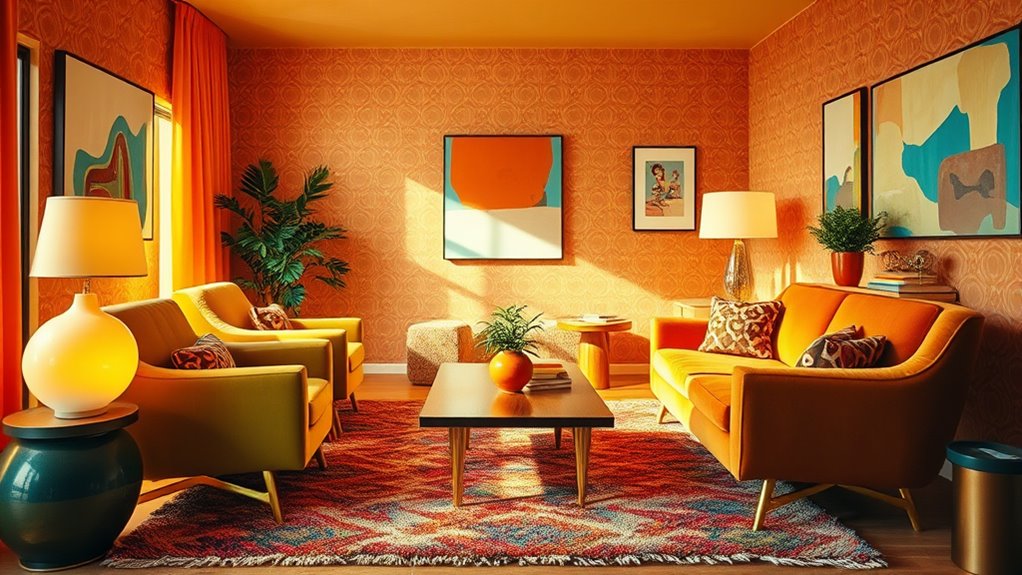
Nostalgia fuels the retro revival by allowing you to reconnect with the styles and moments that defined your past. For many, that means rediscovering vinyl records or using polaroid cameras, which evoke a tangible link to previous decades. These objects aren’t just vintage; they symbolize a desire to relive simpler, more authentic experiences. When you see a vinyl album cover or snap a photo with a polaroid, you’re reminded of a time before digital everything—when physical media and instant prints created a sense of connection and permanence. This longing for authenticity fuels your interest in retro décor, making it more than just style—it’s a way to recapture meaningful memories and emotions from your own history. Moreover, the top 10 anime films of the 1970s continue to influence modern design, emphasizing the enduring power of nostalgia in shaping current trends.
The Role of Media and Pop Culture in Resurrecting Trends
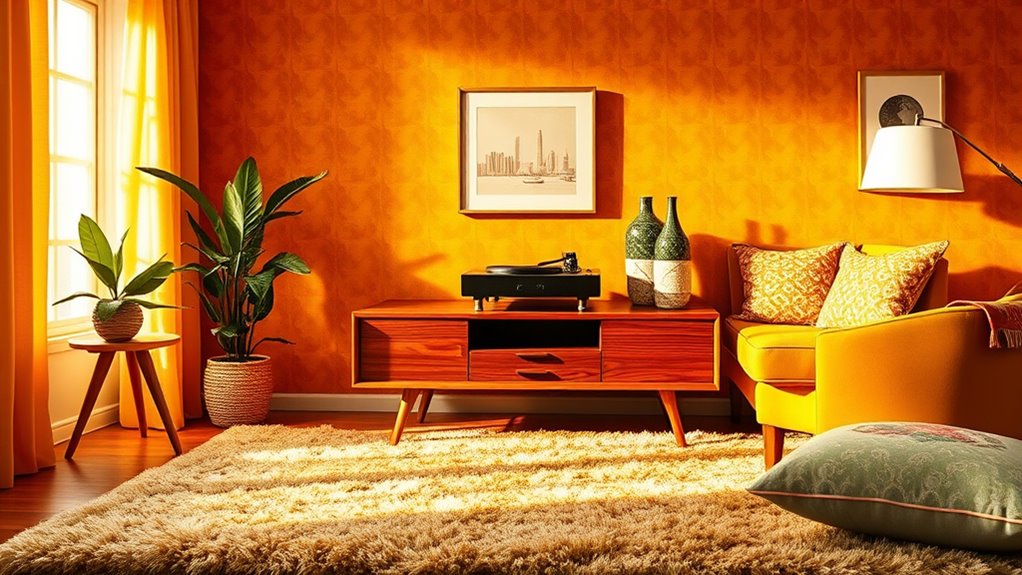
Media and pop culture play a big role in bringing 1970s décor back into the spotlight. When nostalgic media reboots hit the scene, they spark renewed interest in vintage styles. Influencers also drive the trend, showcasing retro elements in modern spaces. Additionally, the resurgence of retro music and fashion influences interior design choices, making the era’s aesthetic more appealing to contemporary audiences.
Nostalgic Media Reboots
When popular TV shows, movies, or music from the past make a comeback, they often spark renewed interest in the styles and trends of that era. Nostalgic media reboots bring vintage furniture and bold patterns back into the spotlight, inspiring new design choices. As you see familiar aesthetics revived in modern media, it encourages you to incorporate those elements into your space. This resurgence makes retro styles feel fresh and relevant again. You might notice:
- Reimagined interiors in movies and shows featuring vintage furniture
- Characters sporting bold patterns reminiscent of the 1970s
- The overall vibe of nostalgia influencing design trends today
- The role of media and pop culture in shaping current interior design trends
These media-driven trends create a cultural ripple effect, making 1970s décor feel both trendy and authentic, fueling your desire to embrace those iconic styles.
Influencers Spark Revival
Influencers and pop culture icons play a powerful role in reigniting interest in 1970s décor by showcasing vintage styles in their content. They highlight how vintage fabrics, with their rich textures and unique patterns, add authentic flair to modern spaces. By featuring bold patterns like geometric prints and psychedelic designs, they inspire followers to incorporate eye-catching elements into their homes. These personalities often share styling tips, making it easy for you to adopt 1970s trends effortlessly. Their curated aesthetic demonstrates that mixing vintage fabrics with contemporary furniture creates a lively, nostalgic atmosphere. As a result, their influence sparks curiosity and motivates many to seek out retro pieces, fueling the trend cycle and bringing 1970s décor back into the spotlight. Additionally, the resurgence is supported by the availability of authentic vintage materials, which makes it easier than ever to incorporate genuine 1970s elements into modern interiors.
Understanding the Trend Cycle and Its Impact on Design

Understanding the trend cycle is essential because it reveals how certain styles, like 1970s décor, periodically come back into fashion. This cycle shows how trends fade and then resurface, driven by factors like nostalgia, innovation, and cultural shifts. Recognizing this helps you see that the trend resurgence isn’t random but part of a larger design evolution. Styles evolve over decades, influenced by past aesthetics and current tastes. When a style reemerges, it often gets modern updates that blend old and new. Additionally, the cyclical nature of trends aligns with the principles of the trend cycle, which governs how fashions reappear over time.
Modern Adaptations of Classic 1970s Elements
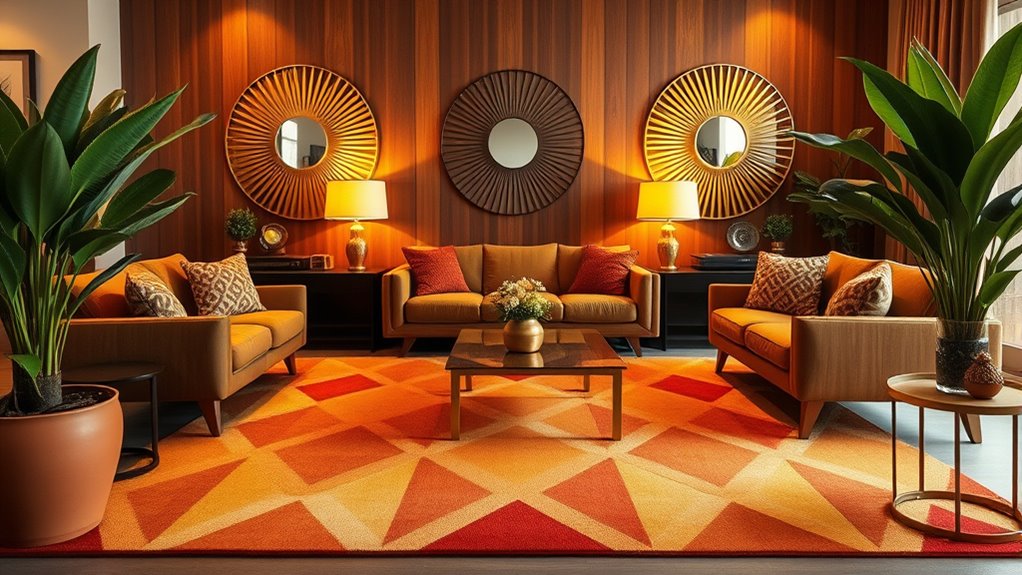
Modern designers are reimagining classic 1970s elements by blending vintage aesthetics with contemporary trends. They often combine mid-century modern furniture with sleek lines and bold colors to create fresh, stylish spaces. You might see retro-inspired lighting fixtures paired with minimalist décor, giving a nod to the past while feeling current. Bohemian chic influences also shine through in layered textiles, eclectic accessories, and relaxed layouts that emphasize comfort and individuality. These adaptations keep the essence of 1970s style alive, but in a way that fits today’s aesthetic sensibilities. By mixing vintage pieces with modern touches, you can craft a space that feels both nostalgic and current, capturing the enduring appeal of this era’s design while making it relevant for today’s lifestyle. Incorporating bicycle-inspired décor elements can also add a unique, dynamic touch to modern interiors, blending functionality with style.
Why Timelessness Keeps Certain Styles in Rotation

The enduring appeal of 1970s décor lies in its ability to adapt seamlessly across generations, maintaining relevance through its timeless qualities. This timeless appeal ensures that certain styles remain in rotation because they resonate regardless of trends. When a design has style longevity, it’s because it captures a universal sense of comfort, versatility, and character. You’ll notice that classic elements like bold patterns, natural materials, and retro silhouettes continue to inspire modern interiors. These features stand the test of time because they evoke nostalgia while still feeling fresh. To keep a style timeless, focus on adaptability and authentic expression. It’s this balance that makes certain décor styles, like those from the 1970s, perpetually appealing and constantly rediscovered.
Frequently Asked Questions
How Long Do Trend Cycles Typically Last in Interior Design?
Trend cycles in interior design usually last about 20 to 30 years, giving each style enough time for popularity and design repetition. You’ll notice that elements from past decades often come back, blending old and new. This trend longevity allows you to refresh your space without constant updates, making timeless styles like 1970s décor reappear when the cycle aligns. So, patience and appreciation for history help you stay stylish.
Can 1970S Décor Be Adapted for Modern Minimalist Spaces?
Ever wonder if 1970s décor can fit into your minimalist space? The answer is yes, but with a twist. You can incorporate mid-century modern elements like sleek lines and organic shapes, then blend them seamlessly with minimalist aesthetics. Focus on neutral palettes and clean surfaces, letting bold textures or vintage accents add personality without clutter. This fusion creates a fresh, timeless vibe—proof that retro and minimalism can beautifully coexist.
What Are the Key Differences Between 1970S and Other Vintage Styles?
You’ll notice that 1970s décor stands out with its bohemian influences and bold color palette choices, unlike other vintage styles that tend to be more subdued. While mid-century modern emphasizes clean lines and minimalism, the 70s embrace earthy tones, vibrant hues, and eclectic patterns. This makes 1970s décor more expressive and relaxed, creating a distinctive, warm atmosphere compared to the more restrained aesthetics of other vintage styles.
How Do Economic Factors Influence Retro Design Trends?
Economic ebbs and flows fuel fashion’s fickle favor, influencing retro revival. During economic recession, you might notice a nostalgic nod to the 1970s, with its bold, budget-friendly designs. When consumer confidence dips, you cling to comfort and familiarity, prompting a resurgence of vintage styles. As your wallets tighten, you gravitate toward affordable, authentic décor, making 1970s décor a smart, stylish, and sentimental choice during uncertain economic times.
Are There Specific Colors or Patterns That Define 1970S Décor?
You’ll notice that 1970s décor is defined by bold geometrics and earthy tones. Think shag rugs with zigzag or circular patterns, and warm colors like terracotta, olive green, and mustard yellow. These patterns and colors create a cozy yet vibrant atmosphere, capturing the essence of the era. Incorporating these elements into your space can give it a nostalgic, retro feel that feels both stylish and inviting.
Conclusion
As the cycle spins like a carousel, 1970s décor reemerges, wrapping your space in a warm, familiar hug. Nostalgia acts as a magnet, pulling vintage charm back into the spotlight, while media fuels the fire with a spark of recognition. This trend is like a well-worn record, timeless and spinning anew—reminding you that good design is a circle, forever coming back around with fresh energy and style.
